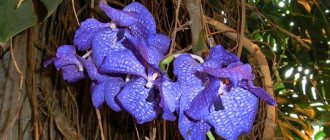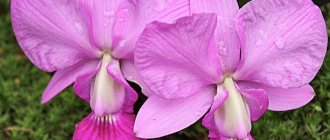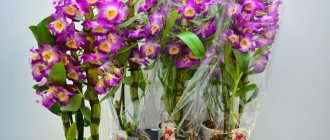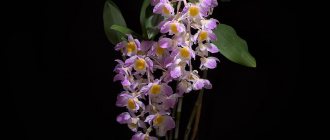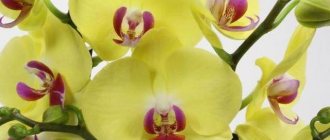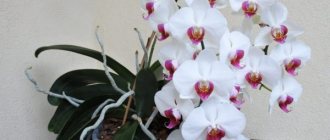Orchids can be found in every corner of the planet. This variety of flowers grows everywhere. The exception is Antarctica. However, not all cultural representatives have beautiful flowers. Most often, phalaenopsis delights with its beauty.
Tropical plants have recently begun to be grown at home. They are increasingly found on window sills in apartments and houses. Today it is impossible to even imagine how many hybrids exist. They differ from each other in a number of ways, including the size of the buds and the duration of flowering. The Royal Orchid is one of the few varieties that belongs to the large-flowered hybrid.
Brief description of the flower
Some researchers believe that orchids appeared relatively recently, about 2.5 thousand years ago, which is quite a bit by evolutionary standards.
These flowers got their name from the word “orchis” - from Greek it is translated as “testicle” (of any mammal, including humans). They were given this name because of the characteristic shape of the rhizome. Some people think that orchids grow on a tree in the rainforest, that is, they are an exotic jungle flower. In fact, they originated in China, and from there they spread throughout the world. These are very popular flowers in Southeast Asia. About 500 species of orchids are grown in Thailand alone. But at the same time, plants from the orchid family are found on all continents except Antarctica. And although it is mainly in the tropics that the most beautiful orchids grow, the species of which most often come to mind first when these flowers are mentioned, orchids also grow in Russia. In total, there are more than 130 species of this plant, of which about a third are listed in the Red Book. About 30 species of orchids grow in the Moscow region.
In total, biologists count 3 groups of orchids:
- Epiphytic plants - they settle high above the ground, on trees, growing right on their branches. These species feed on those small particles of minerals and organic matter that may be contained in the tree bark, or more precisely, in its cracks, where they enter from the air. Interestingly, this category includes phalaenopsis, which today are the most popular among home orchids.
- Lithophytic flowers grow mainly on stones, so they are common in mountainous areas. Their outer roots do not tolerate excessive moisture.
- Terrestrial species also take root well at home, as they easily take root in the soil.
This is a scientific approach to classifying species. In the wild, epiphytic orchids most often grow in the tropics. Temperate latitudes are characterized by terrestrial flowers.
Each group contains many varieties, some of which are very interesting from a biological point of view. There are even varieties of orchids that are known for sexual deception. These are caladenia, ofris and drakea. The flower of such a plant resembles female wasps and bees in structure, color and aroma. This is necessary so that the males of these insects try to mate with the flowers. Of course, they won’t succeed, but pollination will happen. Such deceiver plants grow in Crimea.
Care
The key to productive growth and flowering of the royal orchid will be the creation of the correct microclimate in the room. The primary task is to ensure optimal air temperature, which should be in the range from +24 to +26 degrees. In the winter months, when phalaenopsis is in the resting phase, the temperature will need to be lowered by 4-6 degrees.
The tropical flower loves moisture very much, therefore, in addition to watering, the orchid should be sprayed regularly.
Watering at home can be done in several ways:
- giving the culture a warm shower;
- immersing the plant in a pan of water for some time;
- watering the soil using a watering can with a dispersing spout;
- spraying.
In summer you can bathe the flower every week. After a shower, you need to leave the orchid in the bathroom for a while to allow all the moisture to drain. The leaves should be additionally wiped with a rag. You can leave the flower in a tray with water for half an hour. You can determine that the plant is sufficiently saturated with moisture by the color of the roots - they will turn green.
The orchid can be watered from a watering can every other day, using warm water for watering. When spraying, you should avoid getting too much moisture on the aerial roots. If the royal orchid is grown in a glass vase, then for watering it will be enough to pour water inside the container, leave it there for a quarter of an hour, then drain it.
Lighting for an orchid should be bright, but without direct sunlight on the flower. The optimal place for cultivating tropical crops at home will be a window sill on the southwest side. In winter, during short daylight hours, the plant can be moved to the south side.
As for flowering, if all care requirements are met, a large-flowered crop can bloom up to twice a year without various artificial stimulants. To provoke a crop to flower, you can resort to the option of creating a stressful situation for the orchid. This is possible if there is a significant difference between the day and night air temperatures in the room. As a rule, a fluctuation of 10 degrees downward will be sufficient.
At the end of the flowering phase, the orchid needs to be pruned. To do this, the plant's shoot is shortened, leaving only a small stump at the base. After the procedure, the cut site should be treated with beeswax.
Pests, diseases of vanda and methods of combating them
| Manifestation | Cause | Elimination method |
| Round black markings appear on the leaves along their entire length. | Fungal infection. | Treat infected areas with a fungicide. Reduce the frequency of watering to once a week, maintain a constant temperature of +23...+25 °C. Cover with a cloth, avoid bright light. |
| The horse system rots, becomes covered with a black coating and dies. The stem with leaves dries up. | Bacterial rot. | Remove infected areas and cover cut areas with phytosporin. Replace the soil and disinfect the container. Antibiotics (tetracycline) are also effective in a ratio of 1 gram per liter. |
| Black dots appear on the outside of the leaf, and the stem may become covered with brown lines. | Viral infection. | It is impossible to completely cure. You should get rid of the infected plant to avoid spreading the infection. |
| Small green insects appear throughout the orchid. The stems and leaves wither and the plant dies. | Aphid. | Increase the air humidity, treat the flower with a soap solution or tincture of lemon zest. Special intestinal preparations (Intavir, Actofit) are best suited for pest control. |
| Small beige pests on leaves, flower stalks, buds and stems. White coating and waxy deposits. Wanda is fading. | Mealybug. | Remove growths and affected parts of the plant. Treat the bulb with an alcohol solution and remove the parasites. Aktara, Mospilan, Aktellik, Calypso are excellent for wrestling. |
| Small voids appear on the leaves and stem. Yellow spots appear, shoots die. | Shield. | A solution of soap and alcohol, fern tincture and chemicals such as Permethrin, Bi 58, Phosfamide, Methylmercaptophos will help get rid of the pest. |
Sources
- https://ProZvety.ru/katalog-rastenij/orhidei/orhideya-vanda
- https://komnatnie-rastenija.ru/orhideja-vanda-vyrashhivanie-i-uhod-v-domashnih-uslovijah-foto/
- https://na-zemle.info/komnatnye-rasteniya/dekorativno-cvetushhie/orhideya/vidy-orh/vanda.html
- https://mr-ogorodnik.ru/orhidei/vanda/
- https://orhidei.su/uhod-za-orhideey-vanda.html
- https://dacha.help/cvety/vanda-nyuansyi-uhoda-za-korolevskoy-orhidey
- https://MrDachnik.com/orhideya-vanda
- https://www.ocvetah.com/flowers/komnatnye/orhideya/vid/vanda.html
- https://zen.yandex.ru/media/id/5cc410d110654100b2d87c08/uhod-v-domashnih-usloviiah-za-orhideei-vanda-5ccaec2f583aa800af53753f
Watering and fertilizing
The royal Phalaenopsis orchid, like Vanda, does not like frequent watering. Excess moisture can lead to the death of the plant.
There are three options for watering a flower:
- dipping in a basin of water for half an hour, followed by standing in a tray to drain off excess liquid;
- bathing in the shower;
- directly watering the roots from a watering can;
- moistening the leaves with a spray bottle.
In winter, any of these procedures should be carried out no more than once every 7 days. In summer, you can reduce the intervals between waterings by half. If the soil in the pot does not have time to dry out, becomes compacted, rolls up, the roots are covered with plaque, or an unpleasant damp smell appears, most likely you overdid it with watering. Take a break and then reduce the amount of water, otherwise the flower will die.
Royal orchids can only be watered with high-quality filtered water with low hardness.
Fertilizing is carried out during the growing season. Use a special nitrogen-containing fertilizer for these exotic plants.
Transplantation process
If your home flowers are doing great, don’t rush to replant and increase the volume of the pots. It is important to monitor the development of the root system, which is very important for the life cycle of this subspecies.
Important! Young plants need systematic replanting, and those with large aerial roots find it difficult to take root in a new substrate.
Signs that it’s time to replant your Vanda orchid:
The plant requires an urgent transplant if:
- compacted substrate that does not allow air to pass through;
- the filler does not dry out for a long time, causing rot;
- the roots are buried far into the ground and do not breathe;
- there are signs of rot and disease.
The royal orchid is periodically cleaned, removing degraded leaves and rotten axils of the plant. Cleaning and transferring to another container is carried out only in dry form.
The most popular varieties
As we found out, Royal Phalaenopsis refers to the English name “Phalaenopsis Royal...” from the Dutch nursery “Geest Orchideeën” (VG Orchids), which are good at painting their plants in the brightest colors.
Colors of Phalaenopsis Royal.
There are quite a lot of varieties of Royals, but the most popular are:
- Royal Blue Phalaenopsis has sky-colored flowers. The bole usually blooms in a cascade for quite a long time;
Royal blue.
- Aphrodite Royal became the prototype of the world's first transgenic blue orchid. It was recently developed by Japanese geneticists. It is not yet available to most gardeners;
Aphrodite.
- A cascade is an artificially created direction of growth of a peduncle, thanks to which “arches”, “rings” and other flower shapes are obtained.
Cascade.
- Royal Pink is a Japanese derivative. The standard has a different color scheme; the delicate pink color of the flower will not leave anyone indifferent.
Royal pink.
In addition, there are many more varieties, all of them are united by large flowers and colorfulness during the flowering period.
Where does the color blue come from?
Many orchid lovers wonder where such a bright and rich blue color comes from in orchids. And is there such a species in nature? Let's try to understand this issue.
Interested in whether a blue orchid is colored or not, buyers try to find the answer, which they soon find themselves with the purchase of such a plant. The next time it blooms, it will return to its natural shade. The buds will likely turn either dirty blue or white.
This phenomenon is justified by the fact that in nature orchids are not as deep blue as we see them on store shelves. Therefore, plants are often dyed using a special chemical dye. In many stores where such flowers are sold, small labels are attached to the bowls, where visitors are honestly warned about this. But still, more often than not, they try not to disclose such information, so many buyers, after purchasing a blue orchid, the photo of which is in this article, are subsequently disappointed in their purchase.
For this type of painting, the most often chosen are those types of orchids that are naturally either white or blue. But over time, the dye disappears, and the flower again returns to its natural shade.
Air humidity
All types of orchids require high air humidity - at least 75-80%. It is important to consider that these indicators drop sharply after frequent ventilation in dry weather. It is restored with light spraying. Spraying can be repeated with each ventilation.
It is important to consider that too warm air dries out indoor plants. Therefore, the balance of temperature and humidity is important. In hot weather, light watering should be combined with general air humidification.
Brief characteristics and description of the plant
- Orchids are considered the oldest plants on Earth. Their trace was visible 65 million years ago. Prehistoric remains of this flower were found in Verona.
- Speaking about orchids, it is impossible not to note that this beautiful flower often has a soft purple hue. The orchid has managed to adapt to life throughout the world, except Antarctica.
- The total number of orchids in the world exceeds 25 thousand, and this count is inconclusive.
- The name “orchid” came to us from Ancient Greece and translated it means “testicle”, which confirms the similarity of the shape of the flower’s rhizome with the male part of the body.
What does it look like?
- An orchid is a monopodial flower that has one short stem that grows upward.
- Near the ground, the orchid flower has a rosette with succulent and thick foliage, which absorbs nutrients and moisture. Depending on the type of flower, the length of the leaves can reach sizes from 6 to 30 centimeters. Sometimes there is a characteristic light-colored ornament on the leaf plate.
- The orchid's peduncle is tall and slender. Large bright flowers bloom on it, resembling a butterfly. The sizes of these flowers range from 3 to 30 centimeters.
- Depending on the health of the plant, when an orchid blooms, from 5 to 40 flowers may appear on one peduncle. In the wild, their number can reach hundreds.
- This flower has thick roots of a flattened or rounded shape. With their help, the orchid easily adapts to growth on any surface.
- The size of the buds on an orchid can vary: from 1 to 13 centimeters in diameter. In this case, the inflorescences are usually localized in the axils of the leaves.
Where does it grow?
- Orchids grow on every continent except Antarctica.
- Most representatives of this flower can be found in the tropics. This is due to the fact that tropical latitudes are the most favorable environment for the growth of these plants. Most epiphytic orchid representatives grow in the tropics.
- In the post-Soviet space it will be possible to find up to 49 species of orchid plants.
Varieties
Royal phalaenopsis
The royal phalaenopsis orchid is distinguished by very large flowers. Some of them reach a diameter of 13-15 cm. This royal person is not capricious in caring for her. Prefers a temperature of 22-24 °C and high air humidity of about 70-80%.
In the fall, to stimulate flowering, the orchid should be placed in a cool, draft-free room with a temperature of 14 °C for 2 months. Do not over-water or dry out the roots of the plant.
Multiflora
Multiflora is a small orchid with a huge number of flowers. It has dense, leathery, oval-shaped leaves and small inflorescences up to 6 cm in diameter. During the period of intense flowering, it can form up to 5 peduncles, on which up to 50 buds bloom simultaneously.
The orchid prefers diffused daylight and a temperature of +20-22°C. It requires standard watering once a week and fertilization for orchids. The main feature is the absence of growth buds; shoots develop from the root.
During the period of abundant flowering, the plant requires support, since the peduncles of this orchid are very thin and can break under the weight of the buds.
Wanda
This exotic beauty has a caramel aroma and a long flowering period. Peduncles form in the axils of long narrow leaves. With sufficient lighting and timely watering, the plant produces up to 4 flower stalks with 15 flowers on each. Wanda is quite capricious and demanding of lighting and air humidity.
Mini and midi
- The mini is a smaller version of the full-size phalaenopsis orchid. The plant differs only in small leaves and fewer buds on the peduncle.
- Midi is something between a mini and a standard orchid. For example, if a mini has leaves up to 9 cm in size, then a midi has about 16 cm, while a full-size specimen has about 20 cm.
White butterfly
White butterfly is one of the names of white phalaenopsis, and not its separate species. Remember, Phalania ("moth") and Opsis ("likeness").
white heron
The white heron is the name given to the orchid Habenaria radiata. Its flowers are unique and resemble a flying bird with pearly white wings. This snow-white orchid is especially popular in Japan precisely because of the unusual shape of the bird-like flowers.
The white egret is very finicky to care for!
Before purchasing a flower, you should familiarize yourself in detail with the features of its cultivation. Lack of lighting or excessive watering can lead to disease and death of the plant.
Amabilis
Amabilis is the progenitor of many orchid hybrids. In nature it can be found on the island of Borneo, as well as:
- in Australia;
- in the north of the Philippines;
- in New Guinea;
- on the island of Java.
The plant has a stem from 10 cm to 50 cm, with long elliptical leaves and peduncles up to 1 meter in length. Usually up to 15 flowers appear on the peduncle at the same time, each with a diameter of 7 to 9 cm.
Cattleya
Cattleya is native to the tropical forests of South America. The main feature of this orchid is the middle petal, which has a different color from all the others. The plant has quite large flowers; there can be no more than 5 buds on one peduncle. Cattleya leaves are dense and oval in shape. Growing cattleya at home will require a lot of effort.
Dendrobium
Dendrobium is one of the popular plants of the orchid family. The most common hybrid is Dendrobium nobile, an orchid with powerful shoots and elliptical leaves. But besides its visual appeal, this plant has one indisputable advantage - even an inexperienced amateur gardener can grow dendrobium.
Peculiarities
Mini-orchids are herbaceous plants and are considered perennial. In appearance, they resemble ordinary phalaenopsis, only shorter. That is why it is often called dwarf, because it is the smallest orchid in the world. Their main feature is considered to be small flowers, which can create entire inflorescences, or can be located alone on a regular stem. In fact, this plant often looks like a smaller version of a large orchid.
The height of such phalaenopsis is from 12 to 20 centimeters, everything depends directly on the variety. The flowers are small in diameter, some of them reach up to 7 centimeters in size. The number of petals depends on the age of the mini-orchid. There can be up to 15 flowers on the stem at the same time.
Flowering most often begins in winter and can last more than 1 month.
In nature, these beauties can be found in equatorial forests and among rocky areas. Some of them live not only on tree trunks or on their branches, but even on the leaves of evergreen trees. However, breeders are most interested in those mini-orchids that have small roots and pseudobulbs. The most beautiful among them are those plants whose stem length is equal to the diameter of the flower. Such plants simply fascinate with their beauty.
How does a plant turn blue?
Manufacturers don’t like to talk about how flowers are dyed. But the essence of their method is usually that the plant is placed in a specially created environment. This environment will not cause any harm to the orchid, since it itself is of natural origin.
A hybrid bred in this way by breeders is a fairly successful marketing ploy that allows you to sell more orchids.
It is much more dangerous and harmful to the plant when sellers, wanting to make a big profit, decide to paint the orchid blue on their own. After all, if such a procedure is successful for them, then the cost of this plant will be several times higher.
Most often, such sellers produce coloring using barbaric methods. They use ink as a dye, which is injected either into the root of the plant, into the peduncle itself, or into the stem. Therefore, when purchasing a plant with a blue color, it is recommended to immediately inspect it carefully. Each such injection is stressful for the phalaenopsis, which is precisely the cause of the death of the flower.
Poisoned by harmful dyes, a blue orchid, photos of which show all its beauty, can easily die. But it is worth remembering that when there is a mark from the injection on the peduncle, the plant can still survive. If the injection is made directly into the root of the flower, then there is practically no chance of recovery.
There is another method of coloring an orchid. Sometimes the plant is watered with colored water, so soon a blue tint appears not only on the flower itself, but also on the roots and leaves.
You shouldn’t paint phalaenopsis yourself. Many fans try to cover it with ink. This will not give the orchid a blue color, and the plant itself will die.
Useful tips
In order for the purchased orchids to delight you with their blooms, you need to know and follow a few simple tips. For example, you need to purchase such rare flowers at special exhibitions or in stores. You should not buy an orchid with blue flowers without experience in growing phalaenopsis, as it will soon get sick and may even die.
Always remember that a painted plant requires more careful and thorough care. Therefore, it is recommended to think about whether it is worth buying a blue orchid. No need to paint it blue yourself. If you follow all these recommendations, then an indoor orchid garden will delight any amateur gardener with its varied blooms.
Royal phalaenopsis orchid: how to distinguish it from an ordinary one?
Sometimes, for the purpose of fraud, the store offers us to buy a regular type of phalaenopsis instead of the hybrid Royal one. How to distinguish these two completely different trunks and pay specifically for a large-flowered hybrid:
- These two varieties can be distinguished by the size of the flower, the Royal one is much larger;
- the petals also vary, in the ordinary phalaenopsis almost all have the same size, but in the Royal one, two large ones lie on top of three smaller ones;
- the leaves are large;
- The peduncle of the Royal Phalaenopsis is thicker and higher.
The appearance of the orchid itself tells you what variety it belongs to; carefully examine the standard you are purchasing.
Royal orchid blooms
Long flowering is one of the main characteristics of this plant. Most types of royal orchids bloom from late summer to mid-autumn. Some varieties of phalaenopsis delight owners with flowers almost all year round. Vanda blooms in late September - early October.
The color palette is very wide. Orchids can be white, pink, burgundy, yellow, lilac, purple. Remember, unusual shades like the aforementioned blue, as well as black and green, are not varieties, but artificial coloring. The royal orchid is a quite beautiful flower in its natural color; there is no need to experiment with paint at all.
A flower stalk appears on the trunk of the plant, which will soon produce beautiful orchids. If after flowering, which, by the way, will not happen very soon (in 2 months), it is better not to touch the peduncle. It may dry out and fall off on its own, or it may bloom again after a while.
This vegetative part can also be used to propagate the plant.
Bloom
During the blooming period, the orchid is extremely beautiful; most varieties have a slight scent.
Flowering of the Royal Phalaenopsis usually occurs once a year, the beginning of this period is considered to be early spring. It is during this period that the plant increases its green mass and at the same time expels the peduncle. The arrow develops quite quickly and by the end of April or at the very beginning of May, large butterfly-shaped flowers begin to decorate the trunks one by one.
The total flowering period lasts up to six months; each flower remains fresh and pleasing to the eye with satisfactory care for at least a month.
The royal orchid can bloom for up to six months.
Important! Until the very last moment, until the buds bloom, do not forget to spray the peduncle
Growing
The royal orchid is somewhat more difficult to grow than the regular Phalaenopsis species. However, caring for any variety of this flower at home is based on the same rules.
Planting by seeds
The key to successfully planting an orchid using seeds is correctly collected and high-quality seed material. It is not easy to collect seeds at home.
The algorithm for collecting and processing seed material is as follows:
In order for Phalaenopsis Royal to set several seed pods, it must be pollinated. However, pollination does not guarantee the formation of the desired capsule. The optimal condition is the use of a special Knudson nutrient medium
In its absence, it is assumed to use leaf soil or bog moss. When germinating Royal Phalaenopsis orchid seeds, it is important to maintain the correct temperature conditions. The recommended temperature is between 22⁰ and 33⁰.
High-quality seed material can be obtained in a specially equipped laboratory. For this reason, flower growers often order Royal Phalaenopsis seeds from Eastern countries.
Planting with sprouts
This type of propagation consists of transplanting separated shoots of the plant, which are often called pups.
When using this method, it is important to correctly separate the sprout and plant it in accordance with the recommendations and rules
For propagation of Phalaenopsis, side shoots that have already taken root are used. In this case, the root system is direct evidence that the sprout is able to obtain nutrients from the soil without the help of the mother plant.
For proper separation and planting of the sprout, it is important to follow the following tips:
- The baby is cut off with part of the peduncle (about 1 cm).
- The cut areas on the sprout and the mother plant are dried for 30 minutes, after which they are sprinkled with cinnamon or crushed charcoal.
- Transplant the shoot into a transparent plastic pot, making holes in the bottom.
- The orchid sprout is placed in the middle of the pot, placing the root collar at the level of the edge of the container.
- The roots are carefully distributed over the soil without compacting it.
- The transplanted baby is watered a couple of days after planting in the pot.
The mother plant is watered 5-6 days after the baby is separated. An adult plant can withstand this time without receiving moisture. During this period, the cut areas will be completely overgrown, and the flower will not be susceptible to infections.
Very beautiful blue orchid
White Vanda and its blue varieties will grow and delight their owner with beautiful moth-like flowers if they are properly cared for.
Climatic conditions
The primary task of the florist is to provide the flowers with a microclimate acceptable for their life. Without this, all efforts will go in vain, and cultivation will not give any results.
Caring for a representative of the flora includes creating the following climate conditions:
- Maintain the air temperature within 22-24⁰С. For the growth and flowering of the Vanda genus, the temperature is raised by 2-3⁰С.
- When the flower enters the dormant period, the temperature is reduced by 6-8⁰C.
- Maintain high humidity levels. Spraying or installing a fountain or container filled with water next to the green pet will help.
- Provide bright, diffused sunlight.
In winter, the plant is usually moved from the west to the south. Also in winter, gardeners provide it with additional lighting through lamps.
Watering and fertilizing
Maintaining a watering and fertilizing schedule is also important for growing the Royal Orchid. Maintaining the proper condition of the substrate and ensuring the supply of useful nutrients will help you get a healthy plant that will bloom profusely
Watering should be done moderately
It is important to prevent liquid from stagnating in the pan of the pot. When watering, it is also important to prevent water from entering the outlet.
One way to supply liquid is to immerse the container in water or a fertilizer solution.
Reproduction
Phalaenopsis Orchid
To propagate orchids, the seed method is used, propagation by children and layering, that is, vegetatively. Only experienced collectors can obtain new specimens through cloning.
Seed method
Orchid from seeds
The main condition for seed germination is nutritious soil. And it can only be obtained in a laboratory setting. Here you can achieve sterility.
If someone at home decides to undertake this labor-intensive process - germinating seeds, you need to prepare yourself for the fact that this is a long process and it takes 9 months.
Rastuski grow for 3 years, and only after 4 years can you see the flowering of phalaenopsis. Some flowers do not want to please their owner and do not bloom for 10 years.
Let's look at the process step by step. Seeds should be placed in prepared moist soil consisting of moss and leafy soil and the bowl should be covered with glass. There should be drainage at the bottom. Germination requires high temperature and humidity.
Picking is carried out with tweezers when one leaf develops on the seedlings. Planting in separate pots - after 4 leaves appear on the plant.
How to propagate by cuttings?
Dividing shoots into cuttings
To propagate by cuttings, you need to choose a plant that has only one growth point.
Cuttings should be taken from a healthy mother plant; damaged cuttings can be discarded. Brown spots on the stems of indoor orchids most often indicate that non-infectious or fungal diseases are present, and may be a sign of rot or spotting.
The shoots should only be cut with sharp pruning shears; scissors can damage the internal tissue. The bottom cut must be sprinkled with crushed crushed coal.
When rooting, the bottom of the container should be filled with drainage material. These can be pieces of foam plastic, small fractions of expanded clay, sphagnum moss. You can fill it with pebbles.
All planted cuttings must be covered with polyethylene or a plastic container placed in a greenhouse in which the necessary microclimate will be created. Orchids will grow and develop well.
Plantings should be watered using a spray bottle with warm water, avoiding waterlogging of the soil. Excessive waterlogging will cause rot.
Planting children
The baby appeared on the peduncle
Only some phalaenopsis grown in suitable conditions can produce lateral shoots - babies. They should be separated from the adult specimen carefully, otherwise they will not produce their own roots. To obtain planting material, mother plants must be kept in a room with high temperature.
And also to obtain them it is necessary to apply fertilizers with a high concentration of nitrogen.
After the baby is born, she needs to be protected. And when your root appears, carefully separate it, treat the cut with charcoal and transplant it into a new pot.
Cloning
Orchid
Propagating an orchid by cloning is something only scientists can do. No one can do it at home.
All work on preparing material for propagation is carried out under a microscope in the laboratory. The taken cells are placed in a nutrient mixture. When the nutrient medium turns into clots, it is replaced with a new one. Cell division results in many plants.
A good way to do business selling flowers.
Growing garden blackberries - a description from purchasing a seedling and planting it in open ground to caring for and harvesting from the Moscow region to Siberia (Photo & Video) + Reviews
Suitable growing container and correct soil
Orchids in the wild live on branches and tree trunks, and some subspecies even prefer stones. The roots of this unusual plant feed aerotrophically. Simply put, an orchid does not need soil; it is able to accumulate moisture from the air.
The royal orchid, the photo of which you see in the next illustration, lives in the right container.
This plant must be placed in a transparent plastic container or in a pot with holes. In an ordinary container for indoor plants, the orchid will quickly die.
Some experienced gardeners grow this exotic plant on a large piece of bark or split coconut. The composition looks quite colorful, and the flower is easy to care for. If you like this option, try putting it into practice. But do not forget that in this case, in the first stages, the orchid must be tied to a support.
Flower shops sell packaged soil for orchids. It contains nitrogen and the necessary fertilizers, and also contains large fractions that prevent compaction of the soil and promote aeration.
Landing
The royal orchid has difficulty adapting to new conditions after transplantation, in light of which it would be more correct to carry out this manipulation with the plant only in extreme cases. This concerns the growth of the root system when the old pot becomes too small for the phalaenopsis. Also, the need for replanting may arise if a root disease is detected.
There are certain recommendations regarding the selection of suitable soil for a tropical flower. First of all, it should not interfere with the flow of air to the root system, nor should it retain moisture received during watering. The most suitable option would be crushed pine bark and sphagnum moss. For productive development, it is worth including charcoal, expanded clay and sand in a pot with a flowering crop.
There is also an opinion among flower growers that the royal orchid, indoors and in its natural environment, will not need soil at all. That’s why you can find a crop that will grow in a plastic basket or attached to a piece of tree bark. During this development, the plant will receive moisture and substances necessary for life from the air.
If you have chosen the method of growing a flower in a pot, then the priority will be a container made of clay or polymer containers. To protect the roots, the flower is additionally placed in a wicker pot or basket.
Rooting into the ground involves the following algorithm of actions.
- You must first lay a drainage layer at the bottom of the selected container. This can be gravel or expanded clay, the layer of which should be about 2-3 centimeters.
- After this, the container is half filled with the substrate. The plant is transplanted into a pot without old soil, so it should be carefully cleaned. During cleaning, the right decision would be to inspect the root system of the crop and remove damaged roots, if any. The cuts must be treated with crushed coal.
- The orchid is placed in a pot, the roots in the central part are covered with large bark, the side ones should be straightened and covered with bark and moss of a finer fraction.
Royal orchid variety
Orchids can be found in every corner of the planet. This variety of flowers grows everywhere. The exception is Antarctica. However, not all cultural representatives have beautiful flowers. Most often, phalaenopsis delights with its beauty.
Tropical plants have recently begun to be grown at home. They are increasingly found on window sills in apartments and houses. Today it is impossible to even imagine how many hybrids exist. They differ from each other in a number of ways, including the size of the buds and the duration of flowering. The Royal Orchid is one of the few varieties that belongs to the large-flowered hybrid.
Interesting Facts
- Orchid facts confirm that this plant is pollinated primarily by bees and flies, but there are varieties that grow underground. They are pollinated by animals that live in similar conditions.
- One type of orchid is Kinabalu Gold, and it is the most expensive flower on our planet. It is quite rare and blooms only at the age of 15 years.
- From orchids you can make vanilla, as well as the drink “Salep”. It is believed that “Salep” helps exhausted and sick people, as well as infants. The drink gives strength, tones and promotes a feeling of satiety.
- Orchids are noble flowers and have always been revered in many cultures around the world. In ancient China, for example, the word “orchid” indicated good quality and respect. In Europe, orchid roots were added to potions and drinks.
- Up to 4 million seeds can appear inside one orchid, which makes this plant a leader among flowers in seed productivity.
- Orchids that grow on trees do not parasitize them. They use trunks only as a support and when moving towards the sun.
Phalaenopsis Royal green, 2 stv
Phalaenopsis is native to the dense tropical forests of southern Asia (southern India, Taiwan and the Philippines), New Guinea and Australia. This biological species has up to seventy varieties, in addition, there are thousands more different hybrids and varieties. These are plants with greatly shortened stems.
The leaves are evergreen, 10-30 cm long, collected in a rosette from which flower stalks and aerial roots grow. For its color and shape of the petals, similar to the fluttering wings of a butterfly, this flower was called “orchid-moth” or “orchid-butterfly”. You can find phalaenopsis with a single flower, as well as with many inflorescences that fit on one stem. The stem can reach a length of sixty centimeters and bear up to twenty inflorescences. Phalaenopsis is the most unpretentious plant of the orchid family, and for beginners it is recommended to breed orchids from it. Thanks to its lush and frequent flowering and excellent adaptation to indoor conditions, this plant has become the most popular of the genus of orchids grown indoors. Before purchasing, carefully inspect the plant: the roots should be green and silver.
| Product added to |
| Cart |
Content Features
Phalaenopsis needs an influx of fresh air, but it is important that there is no draft. Almost all species feel comfortable during the day from +22 to +30C, at night not lower than +16
Drafts and excessive heat are dangerous for the plant. A colder temperature promotes flowering, a hotter temperature promotes the appearance of a baby on the peduncle. Phalaenopsis love bright light, and if there is no sun, you can use artificial light (fluorescent lamps). Do not place the orchid in direct sunlight (burns are possible). At temperatures above +35° C, the orchid must be placed in a cooler place, and the roots and foliage should be sprayed with warm water.
Phalaenopsis requires bright light for at least 12 hours in winter. With insufficient lighting, flower growth slows down, and in winter the orchid may go into a dormant state. For additional illumination, fluorescent lamps emitting a white glow are used. However, if you do not have the opportunity to additionally highlight the flower, nothing bad will happen. Your orchid will actively develop in the spring-summer period and rest with the onset of winter.
In order for your orchid to bloom, a number of conditions must be met:
- move the flower pot as little as possible;
- do not allow sudden changes in temperature;
- provide the plant with sufficient light;
- Monitor the air humidity in the room.
Watering
You need to water with filtered, boiled or settled water, abundantly (by immersion), but rarely (in the summer once every 4 days, in the winter once every 7). Wait for the water to drain, remember that overfilling is much worse than underfilling. Irrigation water should not get into the growing point (the center of leaf growth) to avoid rotting.
Fertilizer
Mostly mineral fertilizers with a certain level of acidity are suitable for phalaenopsis. Typically, fertilizers for orchids contain much less microelements than for ordinary indoor plants. When choosing fertilizer, preference is given to liquid forms, as it will save you from the need to weigh and measure proportions
In addition, pay attention to the presence of special ingredients that prevent the accumulation of excess salts
Remember that for a healthy plant, the root type of feeding is preferable. For a plant with a damaged or practically absent root system, spraying can be carried out.
Do you need a substrate?
On an earthen surface, an unusual indoor plant feels even worse than in a “suspended” state. But it is important to cover the upper part of the root system, protecting the flower from drying out.
The Vanda orchid needs a large substrate only so that it does not dry out. This happens in dry air conditions in offices and city apartments.
Other types
You can find other types of orchids in garden centers. For example, this is Angrekum Leonis, which has a peculiar but pleasant smell, as well as sickle-shaped leaves. On the peduncle, no more than three very large flowers with waxy white petals are formed (less often they are ivory-colored).
Flower growers also love zygopetalum - this is a rather rare type of orchid, but extremely beautiful because it is distinguished by its graceful petal shape and unusual color. Beginners are often afraid to purchase zygopetalums, thinking that such an unusual species requires some special, labor-intensive care. But in fact, this is just a common misconception. Caring for zygopetalum differs little from other types of orchids that form pseudobulbs. At the same time, it looks very impressive thanks to petals with various colors and patterns of spots and inclusions. Zygopetalum blooms mainly during the winter months. On one peduncle, from 10 to 20 buds are formed, which then open into medium-sized flowers, emitting a delicate sweetish aroma.
Catasetum is another original variety of orchid. A distinctive feature is the ability to simultaneously form flowers that differ in size and color. And all because both male and female, and even bisexual flowers bloom on one plant. At the same time, they look very decorative.
Cattleya can hardly be called exotic; it is a very common species, which includes varieties with both large and small flowers. In garden centers, Cattleya is represented mainly by hybrids. They can be white, pink, lilac, beige in color.
A very beautiful type of orchid is the dendrobium. It is distinguished by decorative cylindrical leaves and spectacular flowers, the diameter of which can reach 6-8 cm. They are collected several at a time into inflorescences formed on long peduncles. Among the varieties of dendrobium, two-color varieties are especially popular. Dendrobium blooms twice a year, in winter and summer. Depending on the specific variety, the color of the flowers can be pink, beige, or purple.
Cambria is a decorative flowering hybrid. It was obtained by crossing several species of orchids. Its main advantage is the varied colors of the flowers.
It is quite difficult to recognize it among other similar species if you do not pay attention to the flowers themselves - this plant does not look like a butterfly, its flowers are star-shaped. In addition, Cambria is characterized by a shoot type of growth.
Its leaves are narrow and elongated, and have a dark green color. Up to 10 quite large flowers are formed on one peduncle. The disadvantage of this type of orchid is that it is a rather capricious plant, requiring constant maintenance of temperature and light conditions, as well as a certain level of humidity.
Another capricious plant is celogina. It is quite rarely grown at home, since celogina is demanding. But it blooms with very beautiful and fragrant snow-white flowers. It blooms profusely (at least 10 buds are formed on one peduncle), and its flowering period is long - up to three months, so all efforts to grow will not be in vain.
Macodes looks very nice. This plant is distinguished by decorative foliage, which is quite rare for an orchid. And in this case, it has not only a spectacular color with streaks of golden, silver or copper shades, but also a surface that is velvety to the touch. Its leaves themselves come in different shades - from light green to cherry and even amber-black. True, makodes are just as capricious as the species listed above, even if their beauty compensates for all the troubles associated with them.
What species are royal orchids? In fact, such a plant is unlikely to be found in botanical classifiers. Large varieties of phalaenopsis are called royal. However, some varieties of the Vanda orchid also have this name. So it’s hardly possible to talk about any specific species here. In addition, any orchids themselves are so beautiful that they can safely be called royal.
floricultureorchidsindoor plants
Natural habitat
Varieties of orchid crops grow all over the globe with the exception of Antarctica, however, not all plants of this genus are capable of repeated and beautiful flowering. Phalaenopsis should be included in the category of flowering crops. It was these plants that gradually migrated from their natural habitat to greenhouses, botanical gardens and to the window sills of apartments and houses.
Today it is quite difficult to name the exact number of hybrids growing in the natural environment and indoors. As a rule, they differ in external characteristics and flowering capabilities. Plants that bloom with large flowers include the royal phalaenopsis. Flowering trunks of such an orchid can be found in nature in the tropical forests of China, India and Australia. The climatic conditions of these regions are most suitable for the development and flowering of giant crops.
Plants prefer to grow on the bark of trees, in crevices of stones, and orchids also develop well in forests and near ponds and rivers, where there is an appropriate level of humidity and good lighting, without direct sunlight on the crop. Large orchids are distinguished by an impressively sized trunk, which is the main external feature of this type of epiphyte.
Today, thanks to the efforts of breeders, many varieties of large royal orchids have been obtained. The following are especially popular.
Blue Phalaenopsis. The plant stands out for the unusually beautiful color of its flowers. Sky-blue flowers form on the crop in a cascade; the flowering phase is quite long.
Among the species of royal orchid that are in demand for cultivation in closed conditions, it is also worth noting such plants as Gigantea Alba, positioned as the largest orchid in the world, and the interspecific hybrid Ascocenda.

